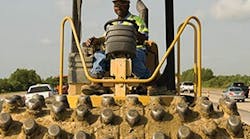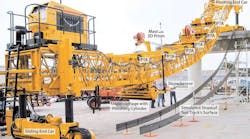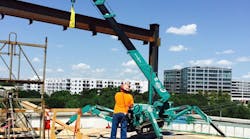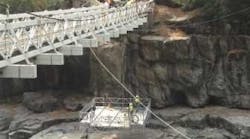It is well known that the aging infrastructure is full of collapsed or out-of-adjustment sewer manhole frames and lids, causing annoying bumps on roadways and traffic hazards. Many of these manholes develop leaks as a result of heavy traffic and from freezing and thawing, causing sanitary overflow problems and expensive repairs.
In repairing these manholes, crews face the challenges of sealing or otherwise repairing the chimney — the top part of the sanitary sewer manhole structure. Traditional repairs require workers equipped with jackhammers or saws to break up the roadway surrounding the manhole, re-level the manhole frame, and then refinish the roadway. This process is time-consuming, typically taking several hours.
However, municipalities and contractors across the country now have another option — the Mr. Manhole leveling system. Mr. Manhole, devised three years ago by Mike Crites, president/CEO of Crites Excavating Inc. and Critex LLC in Lima, OH, allows the removal and replacement of a manhole chimney section and leveling of the frame in less than one hour.
Crites says the Mr. Manhole system provides a leak-free, gas-proof, perfectly road-level fix. He notes that "a couple of thousand" manholes across the country have been repaired using this unique solution for manhole chimneys. Mr. Manhole rebuilds the chimney section of a manhole exactly level with the slope of the road. It also addresses inflow and infiltration problems by quickly removing the chimney and replacing it with a new structural sound, watertight assembly.
The Mr. Manhole system is a quick and effective remedy for municipalities coping with manhole problems, notes Derek Hutchins, president of The Hutchins Group, Louisville — the only certified Mr. Manhole installer in Kentucky. Plus, he adds that the leveling system is cost-effective, typically requiring just a four-person crew to make five to 15 repairs a day versus one to two repairs the traditional way.
In early December, Mr. Manhole was used for the first time in the Bluegrass State. The Hutchins Group used this relatively new process to repair 27 old, masonry manholes for the city of Hardinsburg in Hardin County. "The city's manhole frames and lids were low after years of asphalt paving, which created inflow and infiltration — which is a huge cost to a municipality," says Dave Coburn, vice president of operations for The Hutchins Group. "By raising them with the Mr. Manhole system, they will be able to solve this problem."
In conjunction with key Mr. Manhole tools, The Hutchins Group utilized a variety of Caterpillar machines it purchased from Louisville-based Whayne Supply Co. to perform the repairs. A Mr. Manhole cutter extractor, attached to a Cat 279C compact track loader equipped with a Cat A26B high-flow auger drive unit, was used to cut through the surrounding asphalt and concrete supporting the manholes.
How the Manhole Leveling Process Works
The cutter extractor, a 900-pound machine using replaceable carbide teeth, is capable of dry cutting through asphalt or concrete and removing most manhole frames with no manual labor in less than 20 minutes — a fraction of time required by conventional methods, says Trip Davis, marketing director/sales for Mr. Manhole. The cutter extractor is equipped with a speedplate which centers the cutter's shaft and keeps the unit cutting a true circle. It is capable of cutting diameters from 42 inches to 72 inches by adjusting the position of the cutting arms.
Once a circular hole is cut in the road and the manhole casting is removed, a Mr. Manhole white urethane sealant is applied to the polyurethane insert liner, and the liner is placed on the manhole cone to support the casting — elevating the casting to the proper slope of the road. A Mr. Manhole ringsaw is used to trim the insert liner to the exact height and slope of the road.
Then, an additional bead of sealant is applied to bond the frame to the liner and provide additional assurance against leakage. The manhole lid is replaced and ready-mix concrete is placed as a collar around the casting. One-half-inch epoxy-coated rebar are placed every 6 inches to provide reinforcement and the concrete is consolidated with a vibrator.
The final steps in the process include finishing and smoothing the concrete, and applying a black colorant to the surface of the concrete collar so that it matches the asphalt. A pourable black sealant is used to seal the edge of the rebuild.
The Mr. Manhole system is engineered to stand up to traffic and perform for many years. According to Mr. Manhole, its system has a 20-year design life, will not leak, and will always remain level with the road. The system can withstand loads in excess of four times that experienced by an HS20 loading, immediately upon completion of a rebuild. After that, the system continues to gain more load-carrying capabilities as the concrete cures.




